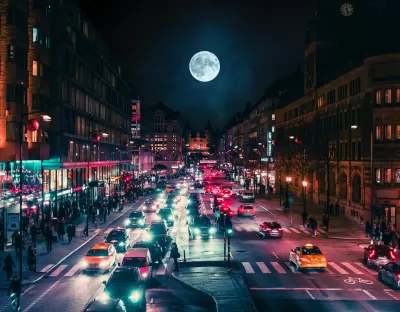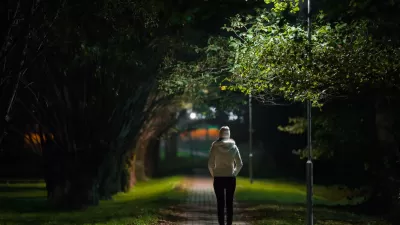More cities are acknowledging the unique role of nighttime activities in urban life and the need for special ‘night governance.’

Writing in Governing, Jess Reia explains why more U.s. cities are hiring ‘night mayors’ to oversee urban nightlife as a “separate, habitable world.”
Reia, who researches nocturnal life, writes that “There’s fear of the dark, safety concerns and noise disturbances. It’s a period that’s ripe for partying, illicit activities and recklessness. And then there are the traditional notions of night: silence, sleep and rejuvenation.” Cities “alleviate some of these fears and facilitate quietude, such as building out a public lighting infrastructure and passing noise codes with special hotlines for noise complaints.”
But nightlife is more complicated. “There have been studies on light pollution and its effects on humans and wildlife, how the shuttering of LGBTQ nightclubs has weakened communities and how late-night venues and businesses spur higher rents.”
Amsterdam became the first city to formally appoint a ‘night mayor’ in 2014, “which set the stage for a bureaucracy of councils, departments and commissions dedicated to governing the city after dark.” New York City followed suit in 2017.
Reia raises concerns about surveillance and privacy as night governance becomes more popular with city governments. “With responsible, careful deployment, however, certain data can be a useful tool for night governance. For example, responsibly tracking movement at night can help cities understand where more nighttime public transit might be useful.”
FULL STORY: Why More Cities Are Hiring ‘Night Mayors’

Alabama: Trump Terminates Settlements for Black Communities Harmed By Raw Sewage
Trump deemed the landmark civil rights agreement “illegal DEI and environmental justice policy.”

Planetizen Federal Action Tracker
A weekly monitor of how Trump’s orders and actions are impacting planners and planning in America.

Why Should We Subsidize Public Transportation?
Many public transit agencies face financial stress due to rising costs, declining fare revenue, and declining subsidies. Transit advocates must provide a strong business case for increasing public transit funding.

Understanding Road Diets
An explainer from Momentum highlights the advantages of reducing vehicle lanes in favor of more bike, transit, and pedestrian infrastructure.

New California Law Regulates Warehouse Pollution
A new law tightens building and emissions regulations for large distribution warehouses to mitigate air pollution and traffic in surrounding communities.

Phoenix Announces Opening Date for Light Rail Extension
The South Central extension will connect South Phoenix to downtown and other major hubs starting on June 7.
Urban Design for Planners 1: Software Tools
This six-course series explores essential urban design concepts using open source software and equips planners with the tools they need to participate fully in the urban design process.
Planning for Universal Design
Learn the tools for implementing Universal Design in planning regulations.
Caltrans
Smith Gee Studio
Institute for Housing and Urban Development Studies (IHS)
City of Grandview
Harvard GSD Executive Education
Toledo-Lucas County Plan Commissions
Salt Lake City
NYU Wagner Graduate School of Public Service





























